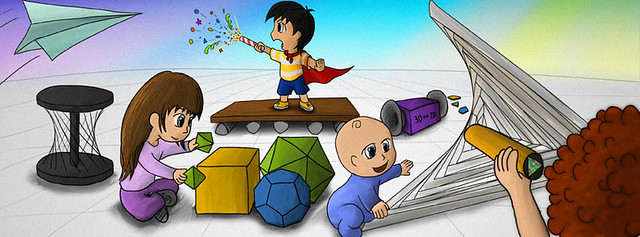Newsletter February 28, 2013

Welcome to adventurous math for the playground crowd! I am Moby Snoodles, and I love to hear from you at moby@moebiusnoodles.com
Book news
We are almost done copy editing. What’s with the “almost” part, you ask? Turns out, it takes a lot of work to craft definitions so they come out just right. And by “just right” we mean both rigorous and accessible. Should we be so particular when defining math terms for little kids? We believe so. In fact, based on our experience playing and talking with children, we know that they are very keen observers who will spot inconsistencies, notice exceptions, and call you up on contradictions. This, combined with their curiosity and fearlessness of complex math ideas makes our task both exciting and challenging.
Last week we went through about a dozen versions of the definition of recursion. The notion appears in chapters on functions and fractals. We ended up with a version from computer science rather than math. We believe it makes the most sense. Check it out:
What do “This Is the House That Jack Built,” slicing pizza, and stacking up blocks have in common? They are all examples of recursion: applying the same operation to previous results. This produces patterns that change in a self-similar ways, much like fractals. You put the next block on top of all past blocks; you repeat – and an amazing block tower grows till the baby knocks it down. You slice each piece of your pizza in half; you repeat – until there are enough slices for everyone. You keep on adding verses – while keeping the entire previous rhyme, much like the block tower:
This is the dog that worried the cat
That killed the rat that ate the malt
That lay in the house that Jack built.
Bold words are also defined in the glossary. We hope our glossary will be a start of a stand-alone resource. There is a general lack of simple rigorous math definitions! For example, Wikipedia has several relevant articles: Yon Yonson and House That Jack Built and Cumulative tale. But click math links in the articles at your own risk, because the definitions assume very formal math background!
Blogs and networks
Our weekly Math Goggles series has two new activities out!
In #6 Yelena invites you to read math stories:
March is a great month for math holidays. First Wednesday of the month is the World Maths Day. Right after it comes the World Science Day. Then, of course, there’s the Pi Day. But first, at least this year, comes the Read Across America Day. So this week’s Math Goggles challenge is to pick up and read a fun math book. If you are not sure what Math Goggles Challenges are all about, check here first. If you are not sure how a math book can be fun, read on.
In #5 you can ascend from cleanliness to mathyness:
I imagined creating an algorithm for a robot to wash my dishes. My algorithm started with the robot checking whether there were any dishes in the sink. If no, it’d stand by or, ideally, switch to a different chore. If yes, then it would turn water on. Then it would soap up the scrubby and pick up the first dirty plate. Scrub, rinse, check, put on a drying rack. Repeat until the sink is empty. Are those the smallest steps that my dish-washing algorithm can be broken into? Of course, not…
Malke, meanwhile, is thinking in threes. Check out the gorgeous Sierpinski fractal made out of clover! Could you use four-leaf clover instead? How?

Sharing
You are welcome to share the contents of this newsletter online or in print. You can also remix and tweak anything here as you wish, as long as you share your creations on the same terms. Please credit MoebiusNoodles.com
More formally, we distribute all Moebius Noodles content under the Creative Commons Attribution-NonCommercial-ShareAlike license: CC BY-NC-SA
Talk to you again on March 15th!
Moby Snoodles, aka Dr. Maria Droujkova
Related Posts
Posted in Newsletter








Leave a Reply